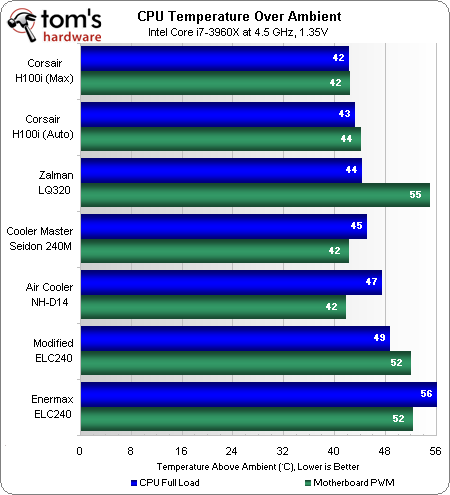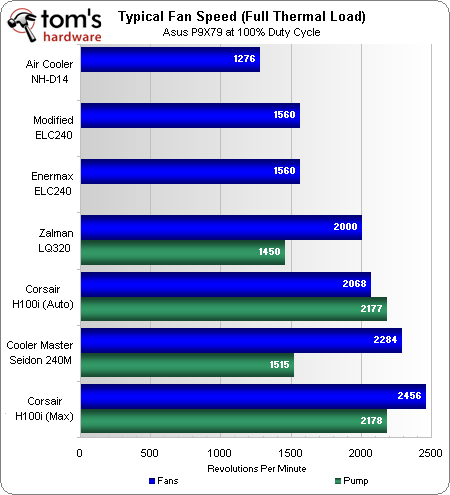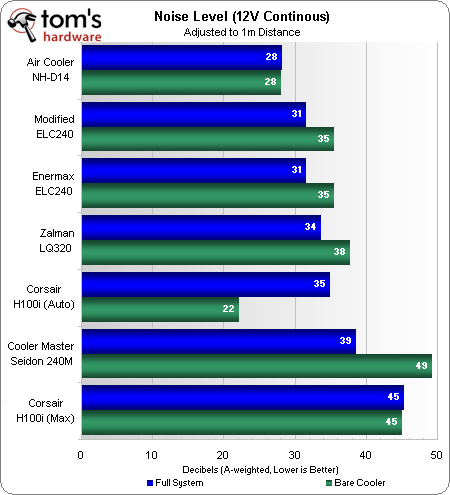Four Closed-Loop CPU Coolers Take On Noctua's NH-D14
Closed-loop liquid coolers relieve stress from our motherboards, without the portability and maintenance issues of traditional open-loop kits. Are these the best devices for system builders who plan to move their machines and want to avoid damage?
Cooling, Fan Speed, And Noise
Our biggest concern with sealed liquid coolers isn’t leaks, but the fact that they don't help dissipate the heat that builds up on a motherboard's voltage regulator circuitry. At one time, those components required a fan nearby when they were operating under a heavy load. Even now, airflow over power logic is a good idea. I’ve recommend devices like Antec’s Spot Cool for many years to combat hot spots, but part of today’s evaluation will focus on how each cooler performs without help.
Corsair’s H100i jumps out of the gate with a fairly significant cooling advantage, going so far as to match the NH-D14 when we look at voltage regulator temperature. With that said, all top-mounted radiators are going to an advantage over Zalman's LQ320 on our test bed. This is because the heat sink covering our motherboard's power circuitry is mounted directly beneath the case’s furthest-back top panel fan.
Remember how we modified the ELC240 with little washers so that its springs would pull tighter to the motherboard? Well, the chart above demonstrates that we didn't make any other changes to fan speed, while the chart at the top of this page illustrates how much more effective our little tune-up made Enermax's solution.
The ELC240 has the second-slowest fan speed, behind our air-cooling reference point, and the correspondingly-lower airflow explains why its temperatures are the highest of all liquid coolers.
Acoustics are different in every case you use, so we're including the noise levels of bare coolers, outside of a case. Unfortunately, that’s not a realistic test scenario for the H100i, since its smart controller spins down almost completely when there is no heat source. Don't worry though; we're using the full system noise levels for our final evaluation.
Lower fan speeds typically result in higher temperatures and less noise, but there's no direct scale between those three variables. Instead, the speed at which a fan achieves its optimal flow-to-noise ratio is based upon the shape of its fins. The ELC240’s low fan speed produces relatively little noise, but its acoustic advantage among liquid coolers appears smaller than its thermal disadvantage. Alternatively, full speed appears to be above the Seidon 240M's optimal RPM, with noise disadvantages exceeding cooling advantages. Cooling-to-noise is going to be a big consideration in our performance analysis.
Current page: Cooling, Fan Speed, And Noise
Prev Page Test Hardware Configuration Next Page Evaluating PerformanceGet Tom's Hardware's best news and in-depth reviews, straight to your inbox.
-
EzioAs Love the title!Reply
Nice review as well. Too bad you didn't test NZXT kraken cpu coolers.
If you ask me, I'd rather stick with the D14 -
mayankleoboy1 Keeping up and beating with all the Water coolers should earn the NH-D14 a "best of the best" award of its own. And its a ~2-3 year old product!Reply -
mayankleoboy1 Small nit : i would have liked to see similar test done with a 3770K and a high OC.Reply -
sluggercz A possibly overlooked benefit of closed loop AIO systems are their ability to fit in SFF cases. While this certainly applies more to the single 120mm radiator designs, some cases (such as the Fractal Design Node 304) can accommodate 240mm radiators)Reply
(Source: Using a Corsair H60 w/ 2 Noctua NF-F12's in push-pull config in my Lian-Li PC-Q08; such large air-coolers as the Noctua could not fit due to the limited vertical clearance above the CPU) -
hero1 Awesome review. Keep it up. I remember commenting about how much better the closed loop CPU coolers have gotten and I got down voted but this just proved my point. I have very sensitive hearing and I can never hear my CoolIt R120(?) spin apart from the initial startup. And this is inside a CM Haf XM. I play games with CPU+GPU OCd to 4.5GHzby 1.2GHz and you can barely hear any noise. First I thought something was wrong then I got my friends and wife to listen whil I played with muted sound and they were impressed. Up next is water cooling my GPU when I add another one in a month in SLI mode. Gaming PCs FTW!Reply -
hero1 BTW DH-14 still deserves an award alongside the H100i and Zalman. Not many, if any air coolers out there can keep up with top notch closed loop CPU coolers.Reply -
hero1 tanjoNo NZXT Kraken and Thermaltake Water 2.0 (which is 3rd gen Asetek iirc)?Reply
Bit-tech.net has a review of Thermaltake water coolers and their top end 240mm took the crown. Better than H100i and the rest shown here.
-
nukemaster With MB control the NH D14 can be very quiet :)Reply
It is HUGE, but I got it for 50$ and to me that was a great value. It was also on for 50$ again at NCIX's boxing day sale.
Sure fills up an SSF system.
Not embedding the image because it may mess up the page.
http://imageshack.us/a/img39/1358/dsc0458s.jpg



